Introduction
The aviation industry is undergoing a significant transformation with the rise of connected aircraft systems. These advanced technologies enable seamless data exchange and communication between different components of an aircraft, as well as with ground operations. The integration of real-time data has revolutionized reliability, operational efficiency, and safety in the skies.
Airlines are embracing new technologies to enhance service delivery and improve operational workflows. As the industry aims to achieve net-zero carbon emissions by 2050, sustainable practices and the exploration of renewable energy sources are becoming crucial. The aviation sector is also adapting to the Internet of Things (IoT) paradigm, which enhances operational transparency and significantly improves the overall customer experience.
Companies like Boeing, Hyundai, Airbus, and Toyota are at the forefront of innovation, developing air taxi fleets that are expected to revolutionize urban commuting. The aviation industry is embracing the future by leveraging technology and data-driven decision-making to optimize operations, enhance passenger experiences, and drive sustainability.
The Concept of Connected Aircraft
The aviation landscape has witnessed a significant transformation, with modern aircraft becoming nodes in an extensive network of data exchange. These 'connected aircraft' serve as platforms for a sophisticated communication matrix that links the various components of the plane and facilitates a seamless dialogue with ground operations. This integration harnesses the power of real-time data, advancing the pillars of reliability, operational efficiency, and safety in the skies.
In this digital era, where data reigns supreme, airlines are harnessing technology to fine-tune their operations and enhance passenger experiences. According to Julie Shainock, global managing director for travel, transport logistics, and hospitality at Microsoft, "An airline of today is not what an airline was four years ago or five years ago." This shift towards embracing new technologies is a strategic move to improve service delivery and operational workflows.
The International Air Transport Association (IATA) has set a target to achieve net-zero carbon emissions by 2050, recognizing that the aviation industry contributes to approximately 2% of global carbon dioxide emissions. This ambitious goal underscores the necessity to adopt sustainable practices, integrate renewable energy sources, and explore the potential of electric or hybrid aircraft.
Furthermore, the aviation sector is adapting to the Internet of Things (IoT) paradigm, which differs from traditional data storage methods by decentralizing data storage, thereby enhancing data privacy and security. The impact of IoT on the aviation industry extends beyond operational transparency; it significantly enhances the overall customer experience.
As the industry navigates through challenges such as rising fuel costs, which have surged by 30% since 2021, and a workforce shortage, there is a pressing need for innovation. Companies like Boeing, Hyundai, Airbus, and Toyota are at the forefront of this innovation, developing air taxi fleets, which are expected to revolutionize urban commuting. Regulatory frameworks in Europe and the U.S. are being established to support the emergence of air taxi operations within the coming decade.
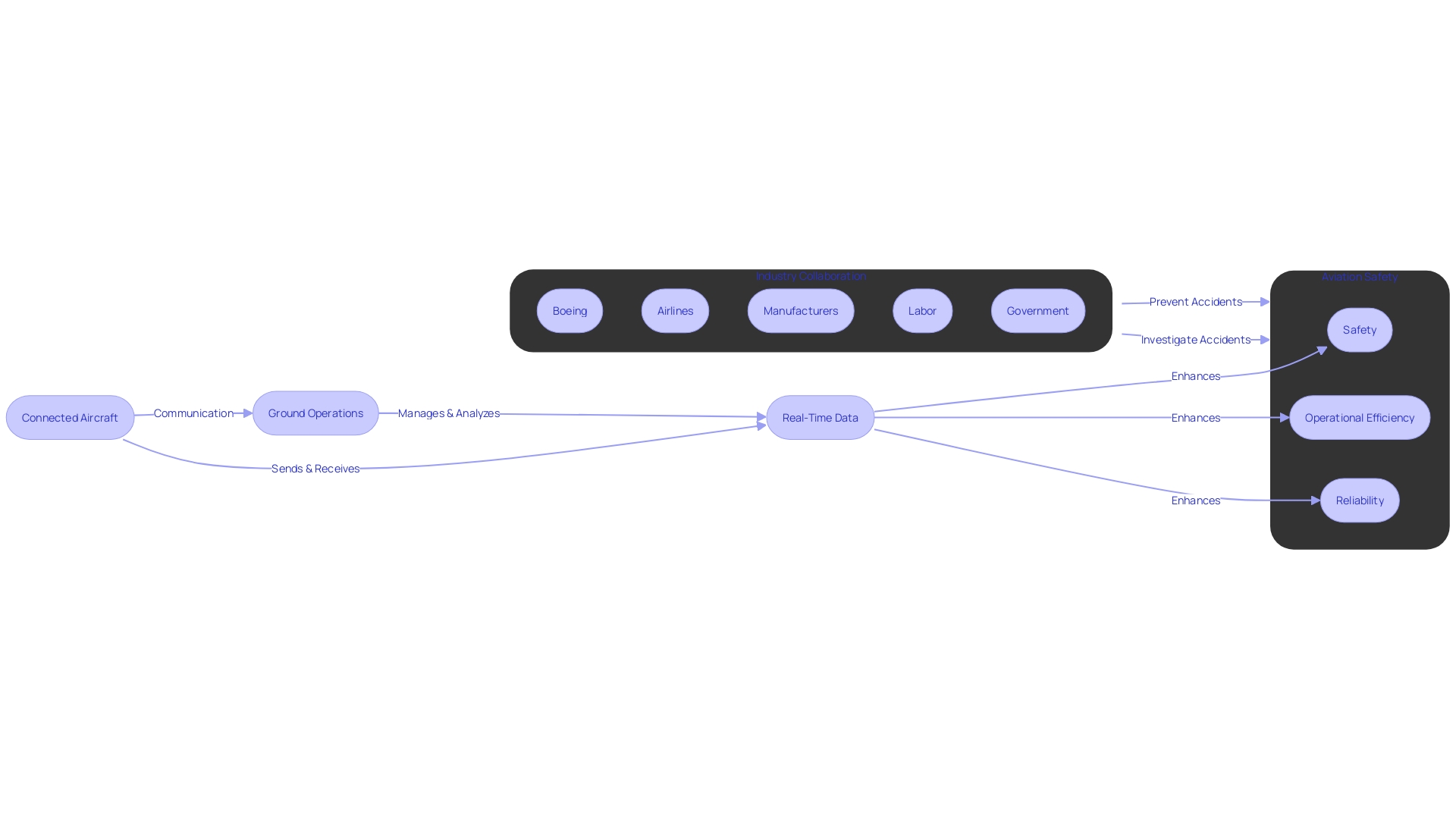
Key Components of the Connected Aviation Ecosystem
The interconnected nature of today's aviation ecosystem is not only revolutionizing the experience for travelers but also driving substantial operational efficiencies for airlines. Central to this transformation is the seamless data exchange and interoperability between onboard sensors, communication systems, ground infrastructure, and data analytics platforms. Together, these components form a formidable Digital Network that empowers airlines to optimize their operations and enhance the passenger experience.
Seth Miller, an industry expert with over a decade of experience, underscores the significance of inflight connectivity, stating that reliable WI-Fi has transitioned from a luxury to an essential service. Airlines are capitalizing on this by offering passengers the ability to stream content, engage on social media, and undertake online activities with the same ease as they would on the ground. The ability to offer such services is a testament to the advanced data systems integrated within the modern aircraft ecosystem.
Moreover, the evolution of airport cities and aerotropolis models further exemplifies the industry's growth. These hubs are not just air transport facilities but have become multifunctional commercial business centers offering a variety of amenities. The development of these airport cities is a direct reflection of the aviation industry's commitment to leveraging technology for enhancing every aspect of air travel.
The recent regulatory changes by the FAA, allowing for more diverse powerplant configurations in Light Sports Aircraft (LSA) certification, are paving the way for electric aircraft and Advanced Air Mobility (AAM) innovations. Such regulatory adaptations are crucial in fostering an environment where technological advancements can thrive.
Finally, the concept of a digital ecosystem is being embraced industry-wide, with airlines being encouraged to take control of their digital strategies. By digitizing aircraft cabins with integrated hardware, software, and data solutions, airlines are provided with unprecedented opportunities to craft unique passenger experiences and harness new business opportunities. As the industry moves towards a more connected and data-driven future, the role of such ecosystems will only grow in importance, ultimately defining the success of the aviation sector.
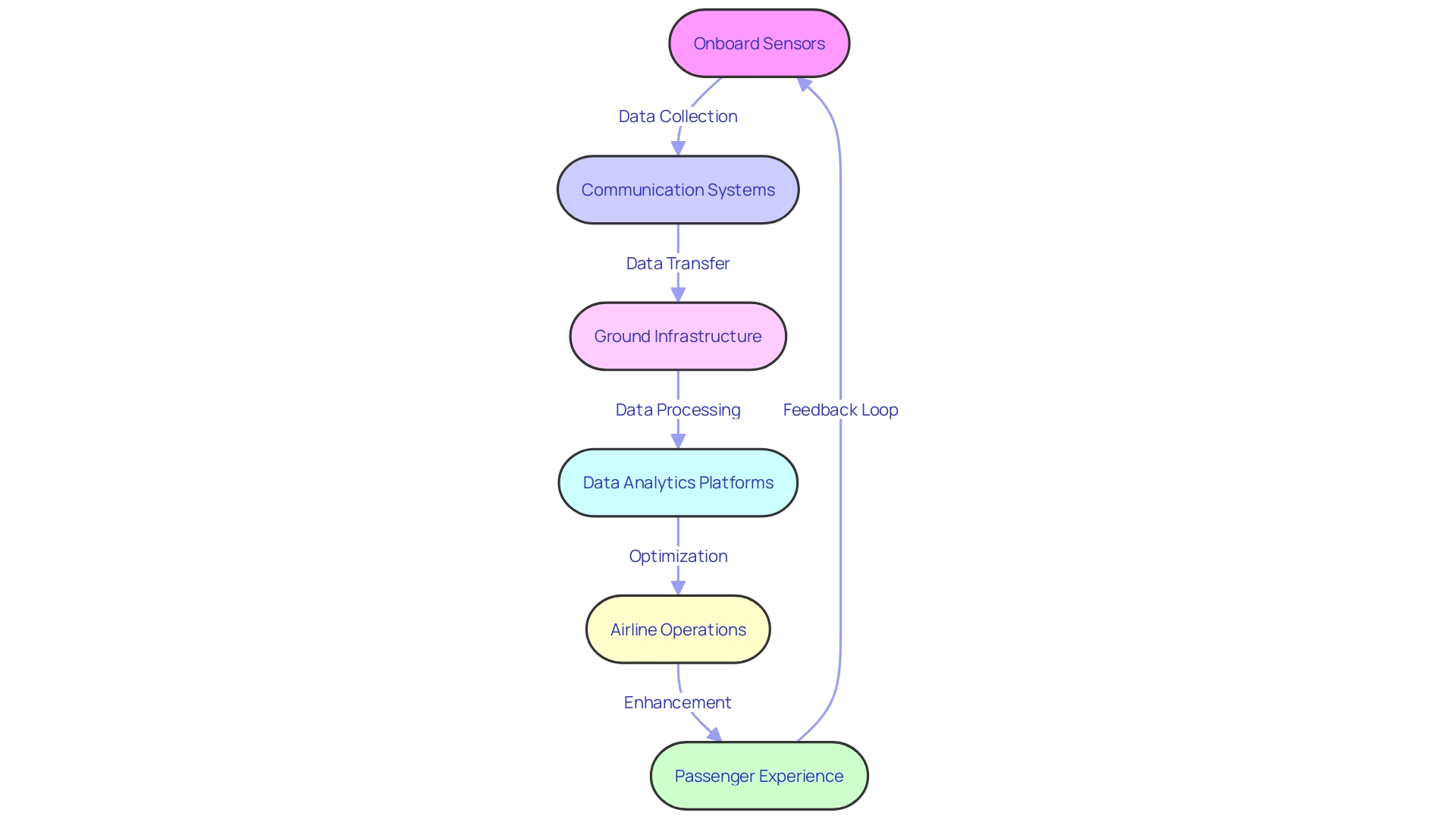
Benefits of Connected Aircraft: Reliability, Efficiency, and Safety
The aviation industry is soaring to new heights with the integration of connected aircraft, which not only elevates the flying experience but also streamlines operational workflows. Real-time data monitoring and analysis, a cornerstone of connected aircraft technology, empowers airlines to proactively troubleshoot maintenance issues before they escalate, ensuring consistent reliability and minimizing aircraft downtime. This technological leap is exemplified by the operations at hubs like the Dallas-Fort Worth International Airport, where American Airlines leverages advanced data systems to manage a complex network of flights efficiently.
Collaborations between airlines and tech giants are fostering a digital transformation that is reshaping the industry. With a focus on customer satisfaction, airlines like Air India are adopting decentralized data systems, significantly enhancing the passenger experience through improved service consistency. The digital ecosystem is rapidly evolving, offering airlines the tools to become architects of their passengers' journey, controlling and personalizing the digital experience within aircraft cabins.
The drive for efficiency extends to fuel consumption, with connected aircraft paving the way for optimized flight paths and smarter resource management. This push towards operational efficiency is not only a strategic advantage but also aligns with the industry's commitment to sustainability, aiming to achieve net-zero carbon emissions by 2050. In this context, data serves as the new oil, providing invaluable insights that enable airlines to adopt more sustainable practices and make informed decisions.
Despite a backdrop of challenges such as rising fuel costs and a global worker shortage, innovation in the aviation sector continues unabated. Airlines are harnessing the power of Internet of Things (IoT) technologies to safeguard data privacy and security while enhancing transparency. In an era where efficiency and customer experience are paramount, connected aircraft stand as a testament to the industry's resilience and forward-thinking approach.
Data-Driven Decision Making in Aviation
The aviation industry is continually evolving, with the integration of big data analytics marking a transformative shift in how airlines and stakeholders approach their operations. By harnessing the power of data from diverse sources such as social media, sensor outputs, and transaction records, aviation professionals are empowered to conduct a comprehensive analysis of every aspect related to customer behavior, market trends, and economic indicators. This holistic approach allows for a nuanced understanding of the industry, ensuring that each decision is backed by accurate and relevant insights.
Big data's role in aviation extends beyond mere collection; it demands a meticulous cleansing and preprocessing to rectify any inaccuracies or inconsistencies. Advanced algorithms then extract valuable insights, shaping strategic decisions that enhance daily operations and lay the groundwork for a data-driven future. This practice is not just theoretical but is exemplified by the Berlin Brandenburg Airport, which leverages AI-based software to optimize handling processes, resulting in improved punctuality and operational efficiency.
The industry has long recognized the value of data, a practice dating back to the early 20th century with pilots logging flight information. However, the scale of data integration has grown exponentially. Today, predictive analytics allows for proactive maintenance schedules, informed by sensor data to ensure aircraft safety and reliability while optimizing fuel efficiency.
Real-time data management is also crucial in air traffic control, where it aids in the smooth routing of flights, minimizing delays and enhancing the air travel experience.
The shift towards data-centric operations is not without its challenges. As noted by researchers Daniel Kahneman and Amos Tversky, decision-making can often be clouded by biases, particularly when it comes to the interpretation of data sample sizes and confidence intervals. To circumvent these pitfalls, the aviation sector must prioritize decision-driven analytics, as emphasized by Stefano Puntoni, advocating for analytics that serve the decision-making process rather than the other way around.
Ultimately, the intersection of data and aviation signifies a promising horizon for the industry. Through meticulous analysis and a decision-centric approach, airlines and their partners can achieve operational excellence, providing passengers with a seamless and efficient travel experience.
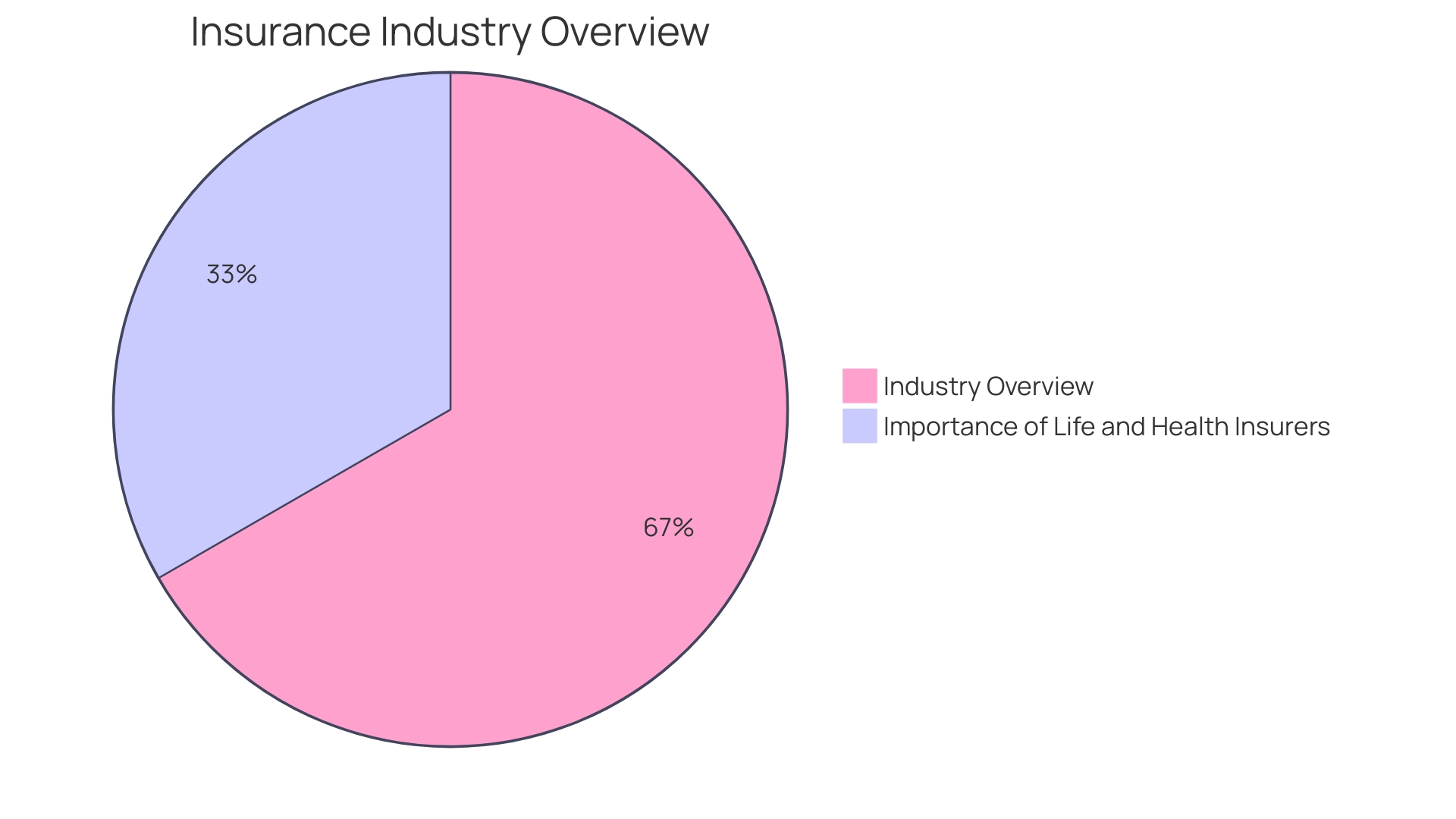
Seamless Data Exchange and Interoperability
In the rapidly advancing aviation industry, where aircraft are becoming more efficient and customer experiences are paramount, the necessity for seamless data exchange and interoperability has never been more critical. Airlines like Air India are revolutionizing the way they engage with customers by integrating diverse technology stacks into a cohesive digital ecosystem. This digital transformation is essential, considering the staggering volume of customer interactions, such as the 550,000 monthly service cases Air India handles.
The development of a digital ecosystem, as advocated by industry leaders like LG Electronics and Lufthansa Technik, is transforming not only cabin experiences but also creating new business opportunities. By digitalizing aircraft cabins with synchronized hardware, software, and data solutions, airlines are empowered to take control of the passenger experience, turning the cabin into a fertile ground for innovation.
As aviation stakeholders gather at events like the FTE APEX Asia Expo to share ideas and drive the industry forward, the conversation inevitably turns to the importance of robust avionic electronics. These systems, subjected to intense vibrations, must perform flawlessly, highlighting the need for standardized communication protocols and cybersecurity that can handle the demands of a connected aircraft ecosystem.
The push for interconnectedness is echoed by thought leaders discussing blockchain's role in enhancing user experience through interoperability. In an industry responsible for 2% of global carbon dioxide emissions, where the goal is net-zero by 2050, the efficiency gains from seamless data integration are not just a luxury but a necessity.
As we prepare for an estimated 7.8 billion annual passengers by 2036, the aviation industry must rise to the challenge, ensuring that every layer of the connected aircraft ecosystem works in harmony. The synergy between ground-based systems and onboard devices is the key to unlocking new capabilities for airlines and providing travelers with the ultimate flying experience.
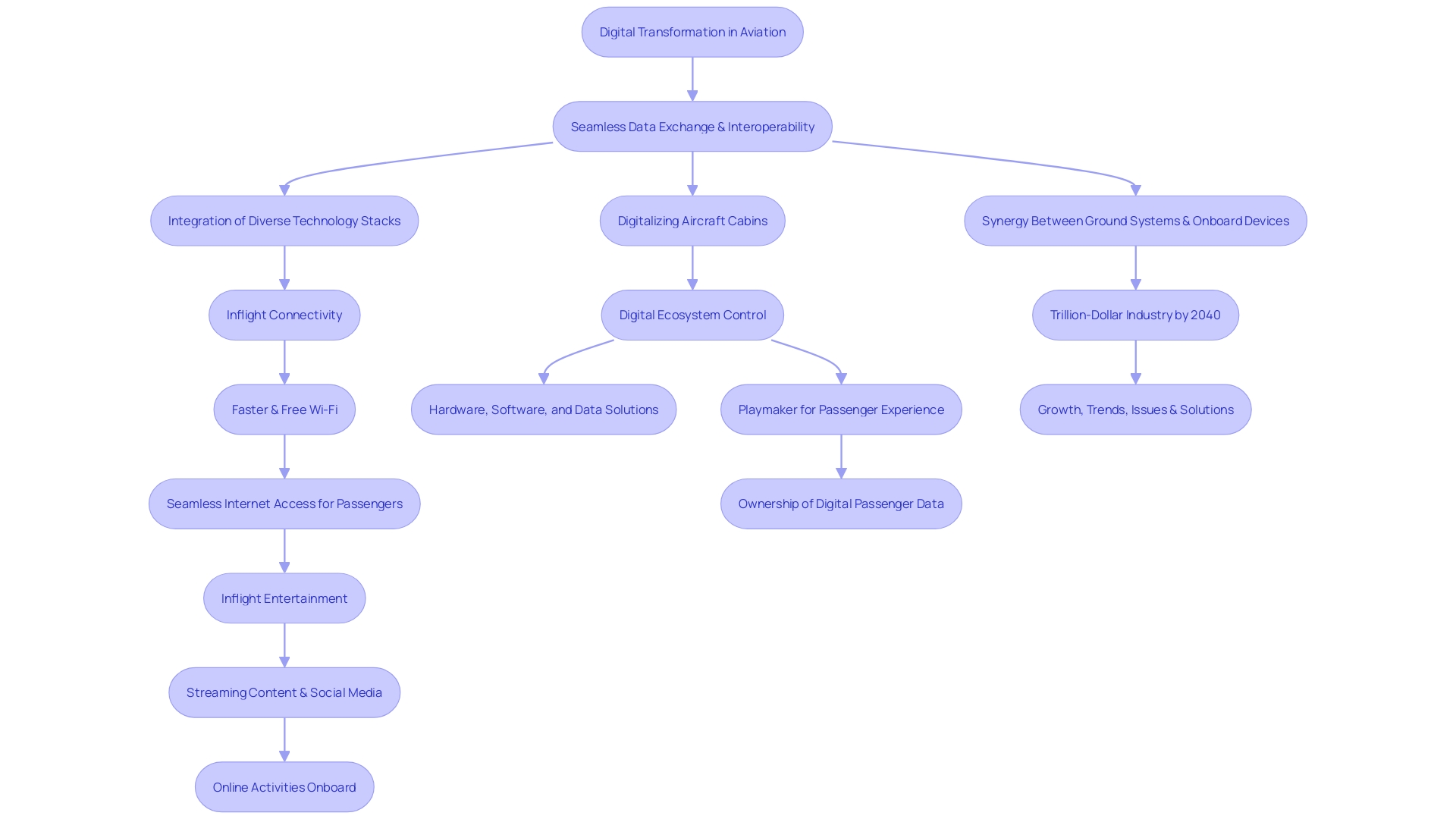
Future Vision and Transition Roadmap
As the aviation industry embraces a future of connectivity, it's witnessing a paradigm shift towards a digital ecosystem that empowers airlines to become the architects of their passengers' experience. Partnerships between tech giants like LG Electronics and aviation specialists like Lufthansa Technik have fostered platforms that digitalize aircraft cabins through a blend of hardware, software, and data solutions, all in harmony. This transformation positions airlines at the helm, enabling them to harness digital passenger data and innovate within their cabins, ultimately fostering new business opportunities.
The creation of a community where knowledge and innovation are shared, such as the one envisaged by FTE Global 2023, is a cornerstone of this transition. Members, including industry captains and startups, collaborate and contribute to advancing air transport. These communities are essential in shaping the interconnected future of aviation, providing a fertile ground for exchanging expertise and fostering partnerships that drive positive change.
Moreover, the integration of advanced technologies like AI and blockchain is set to redefine aircraft operations. AI, stripped of the cloak of mysticism, is a robust tool for crunching data at unprecedented speeds, allowing for real-time analysis and decision-making. It holds promise in optimizing routes, enhancing maintenance, improving drone operations, and offering smarter documentation processes.
The idea is not to replace human judgment but to augment it with precise, data-driven support systems.
Ground navigation aids like VOR and NDB have historically played a crucial role in guiding aircraft safely. However, with technological advances, their significance is poised to diminish as newer, more efficient systems take precedence. This underscores the importance of a well-crafted transition strategy that considers the integration of new technologies while ensuring the reliability and safety of navigation.
Inflight entertainment and services are also undergoing a revolution. Companies like IdeaNova Technologies and AirFi are reimagining the passenger experience by introducing complementary software solutions that blend seatback and wireless IFE. Vietnam Airlines' recent partnership with AirFi to provide IFE and in-seat ordering on its A321 fleet exemplifies this evolution, offering passengers enhanced convenience and a personalized travel experience.
As the industry advances, airlines are not only becoming more fuel-efficient but are also leveraging technology to optimize every aspect of their operations and passenger services. Shainock's observation that the airline of today is vastly different from that of just a few years ago reflects the rapid pace of innovation. With data as the new oil, airlines are gaining invaluable insights that are improving customer and worker experiences alike.
The challenges of transitioning to this interconnected future are numerous, including disparities in safety standards across different regions and the environmental impact of aviation. Sustainable aviation fuel (SAF) represents a promising solution to reduce carbon intensity, though it currently faces hurdles such as limited supply and cost barriers. Addressing the non-CO2 impacts of air travel, such as contrail cirrus formations, is another critical area for the industry's attention.
In conclusion, the interconnected future of aviation is rich with potential, driven by a synergy of technology, collaboration, and innovation. Careful planning and industry-wide cooperation are imperative to navigate the challenges that lie ahead, ensuring a seamless and sustainable progression into the digital age of air travel.
Role of Regulators and Industry Collaboration
The interconnectedness of the aviation industry with regulatory frameworks and stakeholder collaboration is paramount in the development and operation of connected aircraft systems. Ensuring safety, security, and interoperability, regulators set the stage for industry advancement by providing clear guidelines and standards. Industry players such as airlines, aircraft manufacturers, and technology providers must engage in a synergistic effort to foster innovation, share knowledge, and tackle common challenges in connected aircraft adoption.
Retail Business Services' experience in balancing innovation across core business areas illustrates the complexities that can arise when solutions for one objective may conflict with another. Similarly, in aviation, the implementation of one technology must be carefully considered in the context of the entire ecosystem.
Abraham Foss of Avinor highlights the importance of collaborative efforts, as demonstrated in the Scandinavian push towards hydrogen as a sustainable aviation fuel. This regional initiative is a microcosm of the global movement towards sustainable aviation, where stakeholders share expertise and infrastructure to advance green technologies.
Boeing and Airbus are examples of industry leaders taking significant steps towards sustainability. Their focus on sustainable aviation fuels, hydrogen technology, and noise management sets new benchmarks and demonstrates the importance of pioneering efforts in the industry.
The journey towards increased automation in aviation, as championed by Merlin, emphasizes the critical nature of human-machine teaming. It is a reminder that while the path to integrating new technologies is complex and heavily regulated, it is also an essential one for the future of safe and efficient flight operations.
Reflecting on the automotive industry's evolution from cruise control to fully autonomous vehicles, aviation professionals recognize the importance of learning from other sectors. Aviation engineers are exploring how AI-powered autonomy can be integrated into aircraft, ensuring that pilots can effectively interface with and understand these systems.
The collaborative spirit in the aviation sector is further exemplified by the partnership between Airbus and ACI, which leverages technical expertise and operational insights to influence policies and drive industry-wide innovation. Their united approach to sustainability is a testament to the potential of collective efforts in reducing aviation's environmental impact.
These insights and collaborative examples serve as a guiding framework for connected aircraft systems' future, where regulatory clarity, stakeholder engagement, and innovative solutions converge to enhance the aviation industry's sustainability and technological progress.
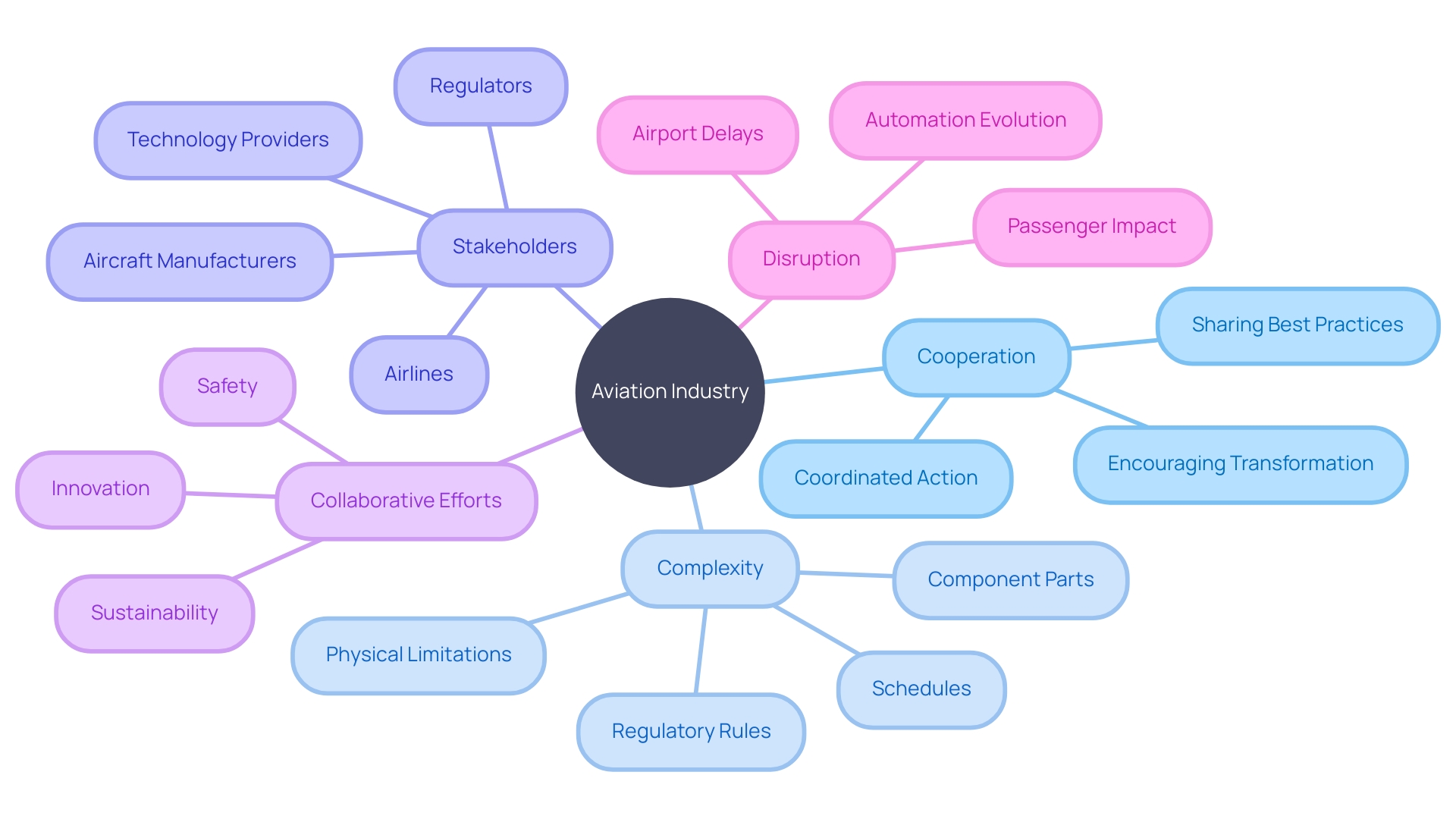
Technological Innovations and Integration
The aviation industry is witnessing a significant shift with the introduction of connected aircraft systems, made possible by the convergence of various technological advancements. These include sophisticated sensor technology, robust communication networks, advanced data analytics, and comprehensive cybersecurity measures. Collectively, these technologies are pivotal in creating an interconnected ecosystem that not only enhances aircraft functionality but also bridges the gap between airborne and ground-based systems.
At the forefront of this transformation is the digitalization of aircraft cabins, a concept brought to life by the collaboration between LG Electronics and Lufthansa Technik. Their intelligent ecosystem is designed to empower airlines by providing them with control over digital passenger data and the cabin experience. This approach unlocks new avenues for innovation and business opportunities within the aircraft's environment.
The industry's commitment to advancing connectivity solutions is evident in the words of Buchman, who emphasizes the importance of meeting the increasing demands for bandwidth, especially for bandwidth-intensive applications such as streaming video and live television. The goal is to replicate the connectivity experience of terrestrial life, ensuring that the aircraft environment does not lag in meeting data requirements.
This technological evolution is reflected in the market growth trends, with the development of airport cities and aerotropolis concepts. Airports are transforming from traditional air transport facilities to multi-functional commercial hubs, offering amenities akin to a modern metropolitan city. The integration of non-aeronautical services, ranging from food services to virtual shopping experiences, plays a crucial role in enriching the traveler's journey and enhancing the overall airport experience.
Industry events like the FTE APEX Asia Expo have become critical platforms for stakeholders to showcase new developments, share ideas, and foster relationships that drive future innovations. These gatherings underscore the aviation community's enthusiasm for technology and its commitment to shaping a more connected and sustainable future for air travel.
In the context of digital transformation, the aviation industry is not merely automating existing processes but is adopting a holistic approach to leverage technology. This approach is aimed at driving innovation, improving operational efficiency, and enhancing customer experiences. As the industry continues to navigate through the digital landscape, the integration of these technological advancements signifies a promising direction for the future of aviation.

Case Study: Implementing Connected Aircraft Solutions
United Airlines and Icelandair have demonstrated significant advancements in connected aircraft solutions, providing valuable insights into the transformative effects of digitalization in aviation. United Airlines, with its vast network and extensive cybersecurity measures managed by experts like Chris Peters, has exemplified the integration of connected systems to enhance operational technology across multiple hubs. The security of operational technology devices is crucial for the airline's expansive fleet that traverses the globe.
Likewise, Icelandair's strategic use of its geographical location has allowed it to establish a robust international network, with an emphasis on safety, reliability, and exceptional service. By partnering with Omnevo, Icelandair has embraced digital solutions to enrich the cabin experience for passengers and open up new revenue streams.
The industry is witnessing a paradigm shift, as noted by aviation technology experts like Shainock, who underscores that today's airlines are not what they were just a few years prior. Airlines are increasingly adopting technology to refine operational processes and enhance passenger experiences. Data now serves as the lifeblood of the industry, providing pivotal insights that aid in decision-making and improving overall service quality.
Innovative platforms like Blueview and AirFi's wireless inflight entertainment solutions are at the forefront of this digital engagement, empowering airlines to connect with passengers in novel ways. Such platforms not only deliver engaging content but also allow airlines to generate ancillary revenue through interactive services.
Moreover, the introduction of IdeaNova Technologies' InPlay Flow points to a future where seatback inflight entertainment and wireless systems complement each other, offering passengers seamless access to a range of digital services. This integration is crucial for busy travelers who need to utilize their time efficiently while in transit.
As the aviation industry continues to evolve, the focus remains firmly on enhancing the passenger experience, which is evident from the survey results with CJI Magazine, where industry players ranked passenger experience as the top benefit of improved in-flight connectivity. This commitment to passenger satisfaction is a shared objective across the sector, proving to be a driving force behind the adoption of cutting-edge connected aircraft solutions.
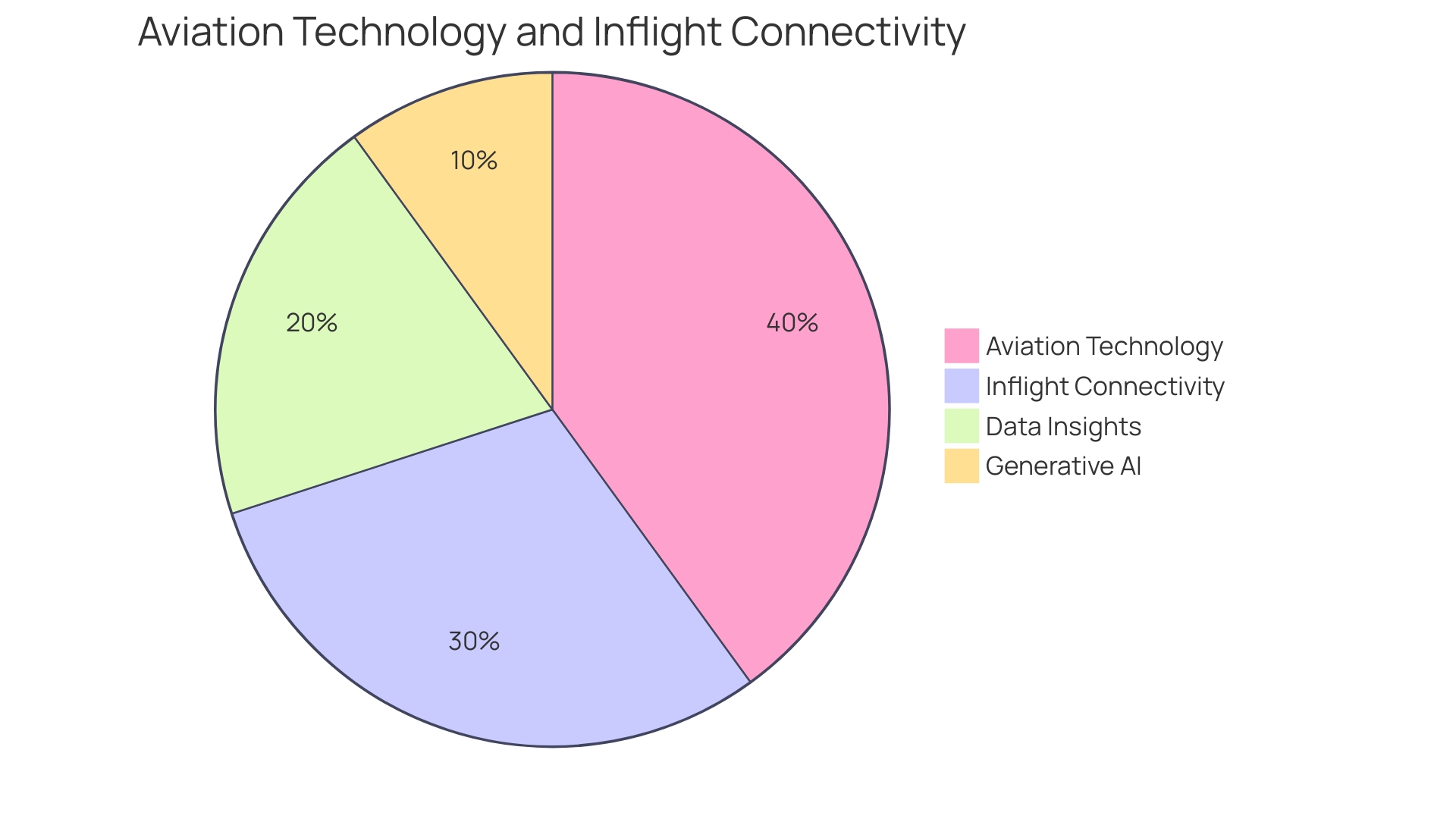
Challenges and Opportunities in the Connected Aviation Ecosystem
The evolution of aviation technology has not only increased fuel efficiency but also enabled airlines to enhance customer experiences with personalized services. The connected aircraft ecosystem is a testament to this progress, offering an array of benefits from operational efficiencies to enriched passenger interactions. However, it is also fraught with challenges such as cybersecurity threats, data privacy issues, and the complexities of new infrastructure and regulations.
Cybersecurity incidents, like the one Boeing experienced, underscore the criticality of robust protection mechanisms within the interconnected aviation space. The need for advanced intelligence and analysis, as offered by expert teams like OODA, is imperative for ensuring the safety and security of airline data.
Additionally, the industry must address the data privacy implications of IoT technologies, which offer a decentralized approach to data storage, enhancing both privacy and security. This technology is not only transforming operations but also revolutionizing the passenger experience by streamlining processes and increasing efficiency.
The push for sustainability presents another dimension of opportunity and challenge. With the aviation industry contributing approximately 2% of global carbon dioxide emissions, there is an urgent need for sustainable practices. The potential of Sustainable Aviation Fuel (SAF) to reduce the carbon footprint by over 80% is significant, yet its adoption is hindered by limited supply, cost barriers, and fragmented demand.
Despite these hurdles, the connected aviation ecosystem holds immense potential. Organizations like the one founded by LG Electronics and Lufthansa Technik are leading the charge, creating digital platforms that empower airlines to become the architects of their passengers' experience and seize new business opportunities.
To navigate these challenges effectively and realize the opportunities, stakeholders in the aviation industry must engage in proactive planning, foster collaboration, and commit to strategic investments. By doing so, the industry can harness the full potential of the connected future of aviation, offering unparalleled efficiencies, customer experiences, and a path towards more sustainable operations.
Conclusion
The aviation industry is undergoing a significant transformation with the rise of connected aircraft systems, enabling seamless data exchange and communication. Airlines are embracing new technologies to enhance service delivery, improve operational workflows, and drive sustainability. The integration of real-time data has revolutionized reliability, efficiency, and safety in the skies.
The interconnected nature of today's aviation ecosystem is revolutionizing the traveler experience and driving operational efficiencies. Seamless data exchange and interoperability empower airlines to optimize operations and enhance the passenger experience. Connected aircraft technology allows airlines to proactively troubleshoot maintenance issues, ensuring consistent reliability.
Big data analytics provide comprehensive insights, enabling informed decision-making.
Digital ecosystems empower airlines to become architects of the passenger experience, harnessing digital data and fostering new business opportunities. Regulatory frameworks and stakeholder collaboration ensure safety, security, and interoperability in the development and operation of connected aircraft systems. Technological advancements create an interconnected ecosystem that enhances aircraft functionality and bridges the gap between airborne and ground-based systems.
Connected aircraft solutions, exemplified by United Airlines and Icelandair, showcase the transformative effects of digitalization in aviation. These solutions enhance operational technology, enrich the cabin experience, and open up new revenue streams.
The aviation industry is embracing the future of connectivity through connected aircraft systems. By leveraging technology, collaboration, and innovation, the industry aims to optimize operations, enhance passenger experiences, and drive sustainability. Careful planning, industry-wide cooperation, and proactive measures are crucial to navigate the challenges and ensure a seamless and sustainable progression into the digital age of air travel.
Embrace the future of connectivity with our cutting-edge connected aircraft systems!




